Women’s Worldwide Web interviews Robin Smalley, Co-Founder of mothers2mothers
W4: You have a background in television and the entertainment industry, which seems far from the world and work of mothers2mothers. How did you find out about Dr. Besser’s project? And what inspired you to (jointly) found m2m and move to Cape Town to work on the organization’s development?
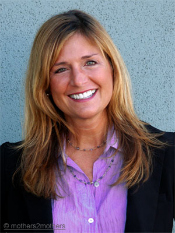 Robin: Well, Mitch Besser is one of my oldest friends. I’ve known him for about 35 years. In fact, his sister Karen was my best friend in college. The Bessers were like my second family and Karen couldn’t have been more of a sister. In 2004, Karen went into hospital for what was supposed to be minor shoulder surgery. However, she never came out of anesthesia. I was called immediately to go and be with her where she lived in Chicago. When it became clear that the situation was very serious, Mitch flew in from Cape Town (where he was living with his family) and we sat with Karen for two weeks while she was in a coma. It was then that Mitch told me about the idea he had for mothers2mothers. I was running a non-profit here in Los Angeles, called The Media Project. When Karen passed away, I went into a tailspin, a real depression. I had gone through a very difficult couple of years; I had lost my mother, and my stepfather, and had breast cancer… all of which Karen had supported me through—and now she was gone. Mitch asked me to come to Cape Town just to see what he was doing, and so I did. On my first full day there, I went on rounds with him and I just fell in love with the spirit of the women he was working with; I was so inspired by how they were dealing with their lives, with the courage they displayed, with their joy in life, despite overwhelming obstacles. I called my husband that night and said, “I want to do this. We need to move to Africa”. Literally four weeks later, there we were!
Robin: Well, Mitch Besser is one of my oldest friends. I’ve known him for about 35 years. In fact, his sister Karen was my best friend in college. The Bessers were like my second family and Karen couldn’t have been more of a sister. In 2004, Karen went into hospital for what was supposed to be minor shoulder surgery. However, she never came out of anesthesia. I was called immediately to go and be with her where she lived in Chicago. When it became clear that the situation was very serious, Mitch flew in from Cape Town (where he was living with his family) and we sat with Karen for two weeks while she was in a coma. It was then that Mitch told me about the idea he had for mothers2mothers. I was running a non-profit here in Los Angeles, called The Media Project. When Karen passed away, I went into a tailspin, a real depression. I had gone through a very difficult couple of years; I had lost my mother, and my stepfather, and had breast cancer… all of which Karen had supported me through—and now she was gone. Mitch asked me to come to Cape Town just to see what he was doing, and so I did. On my first full day there, I went on rounds with him and I just fell in love with the spirit of the women he was working with; I was so inspired by how they were dealing with their lives, with the courage they displayed, with their joy in life, despite overwhelming obstacles. I called my husband that night and said, “I want to do this. We need to move to Africa”. Literally four weeks later, there we were!
W4: How did you succeed in persuading your husband to move to Africa?
Robin: You know, it’s bizarre… um [laughs briefly] my husband is somebody that I couldn’t even persuade to move across town. He’s a real homebody. However, when Karen died, I think he was really concerned about my emotional stability. I just didn’t want to come out from under the covers. My husband is an extraordinary man, realizing this was a “for better or worse” scenario, he accepted the move for the sake of my sanity. He was willing, at that point, to do whatever it took to get me launched again. And so he and I, with my two daughters (who were 12 and 15 at the time) and our two dogs, all uprooted—to the horror of our friends and family—and started on the greatest adventure of our lives.
W4: Wow! It sounds like it was the right choice at the right time, to pack up and move to Cape Town.
Robin: Isn’t it great when hindsight works out? What I learned is that when we’re immersed in our troubles, our tragedies, and are then exposed to the kind of women that we are privileged to work with at m2m—who are so strong and have overcome so much adversity and managed to maintain their sense of grace and gratitude and their spirit—well, it’s like a bucket of water over the head. It forces you to recognize what’s important and find the strength to go on. And I continue to learn and be inspired by these women. I feel very, very grateful.
W4: Can you tell us about the origins of your Mentor Mothers program? How was the model initially received in the medical facilities where you operate? And how has the program evolved over time?
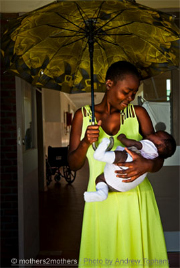 Robin: Mitch had moved out to Cape Town with his family back in 1999. He is a gynecologist/obstetrician from Harvard and could easily have taken the traditional route of earning money and prestige with a private practice and all that. But he had always had a passion for global public health. He moved to Cape Town and volunteered his services at Groote Schuur Hospital, the largest public hospital in Cape Town, where he recognized a terrible gap in services. The fact was that, while the medications to prevent mother-to-child transmission of HIV were increasingly available, women just weren’t accessing them. You have to understand the medical infrastructure in sub-Saharan Africa. There are very few doctors, so everything is run by nurses who are overwhelmed, overworked, and overstressed. The last thing the nurses have time to do is to counsel and educate a frightened young woman who has just been diagnosed with what she sees as a death sentence. Imagine, these young women were coming into hospital for their first antenatal visits, filled with joy and anticipation, being offered their first HIV tests. When the test would come back positive, there would be nobody to tell the mother-to-be that she had options, that it was possible to prevent the transmission to her child—indeed, that it was possible for her to stay alive to raise her child. This young woman would be terrified, convinced she and her baby were going to die. And because of the terrible stigma in the community, she would be afraid to disclose the truth to anyone. She would leave the clinic, carrying this terrible secret in isolation, and never return again.
Robin: Mitch had moved out to Cape Town with his family back in 1999. He is a gynecologist/obstetrician from Harvard and could easily have taken the traditional route of earning money and prestige with a private practice and all that. But he had always had a passion for global public health. He moved to Cape Town and volunteered his services at Groote Schuur Hospital, the largest public hospital in Cape Town, where he recognized a terrible gap in services. The fact was that, while the medications to prevent mother-to-child transmission of HIV were increasingly available, women just weren’t accessing them. You have to understand the medical infrastructure in sub-Saharan Africa. There are very few doctors, so everything is run by nurses who are overwhelmed, overworked, and overstressed. The last thing the nurses have time to do is to counsel and educate a frightened young woman who has just been diagnosed with what she sees as a death sentence. Imagine, these young women were coming into hospital for their first antenatal visits, filled with joy and anticipation, being offered their first HIV tests. When the test would come back positive, there would be nobody to tell the mother-to-be that she had options, that it was possible to prevent the transmission to her child—indeed, that it was possible for her to stay alive to raise her child. This young woman would be terrified, convinced she and her baby were going to die. And because of the terrible stigma in the community, she would be afraid to disclose the truth to anyone. She would leave the clinic, carrying this terrible secret in isolation, and never return again.
These young women were continually falling through cracks in the medical system, never accessing the treatment that was available. Realizing that the greatest resource we have in Africa are the women themselves, Mitch came up with the idea for mothers2mothers: to take newly-delivered moms who are HIV positive, and provide them with rigorous training according to a thorough curriculum and send them back into their own antenatal units to provide other HIV-affected women with support and guidance. This is the concept of Mentor Mothers. Now, when a young woman comes into a clinic and gets this potentially devastating diagnosis, immediately a Mentor Mother is called to hold her hand, to put her arms around her and say, “You’re not alone. I’m positive too and my baby was born negative and healthy—and yours can be, too.” From there, the young woman is taken to the mothers2mothers room, which is always located right there in the antenatal unit, and she is surrounded by a sisterhood of women who are just like her. The young woman can be counseled every day on things pertaining not just to her HIV status, but to her pregnancy status—the medications that are available, nutrition, exclusive feeding for her child, dealing with domestic violence, indeed all the things that she has concerns about but usually cannot discuss with anyone. We give her a good, hot meal, often the only good meal that she might get that day. Her Mentor Mother is her advocate during labor and we keep the new mother in the program ideally until 18 months after her baby is tested HIV negative, so the Mentor Mother can support her in her feeding of her baby and act as a bridge to other crucial medical care, to well-baby care, to inoculations, to TB care, to reproductive healthcare, and to all the ongoing support that a new HIV-positive mother needs. The fact is that the availability of medicine does not equal medical care. Clinics can provide the medicine, mothers2mothers provides the care.
W4: How was this model initially received? Was it easy to persuade the women to enter the program? What were the challenges with this model, if any?
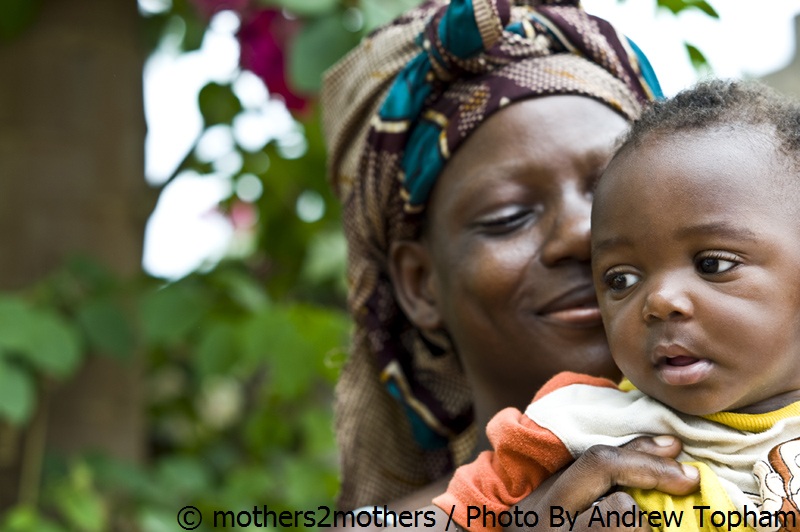
Robin: There were lots of challenges, especially at the beginning. One of the major controversies around the m2m program is that we pay our Mentor Mothers. We don’t believe in volunteerism, particularly for women struggling to put food on the table. We are very much about empowerment and we strongly believe that you can’t make people feel valuable unless you treat them as though they are of value and their time is of value. So we pay our Mentor Mothers, which was at first very discomfiting in a society that relies on women as volunteers and doesn’t think that their time is worth money. That was the big challenge at the beginning.
In terms of getting mothers to participate, it was very empowering for them to be paid. By paying them, you create role models in townships and villages and communities, and women gain tremendously in status. The only prerequisite we have for becoming a Mentor Mother is that the woman has to have disclosed her HIV status. This is critical because it is virtually impossible for her to make healthy choices that may go against societal norms if she is keeping secrets. It can take tremendous courage to disclose, but having the possibility of employment while helping her community is a big incentive.
In terms of support from the medical system, the clinics and hospitals where we operate have always been very cooperative because we are effectively providing necessary support for the nurses on staff. We go to them and say, “We are here to support what you’re doing, to give you more time to do what you need to do,” which is the medical intervention. We provide the psychosocial support that the nursing staff doesn’t really have time for. Our Mentor Mothers are managed by Site Coordinators who are also HIV-positive moms promoted from the Mentor Mothers, so we don’t add any burden to the already over-stressed nursing staff. We manage our own people; we are there to add value to the medical team. As a result, we’ve really been embraced by the system, and our mothers have grown into a third tier that bolsters the infrastructure. We don’t expand into a country without the full support of the Ministry of Health.
This cooperation has enabled m2m to flourish: we began in 2001 with one site in Cape Town. Today we have over 700 sites in 9 countries, and we employ over 1,800 HIV positive moms. We’re currently reaching one out of every five pregnant women living with HIV in the world.
W4: It’s phenomenal, the amount of success you have achieved in just over nine years, and regardless of societal context. How has your program evolved over time? What are key aspects that you’ve noticed developing since the beginning of your program?
Robin: When I moved to Cape Town, we were just opening our first office. It’s been a quite an adventure ever since! In terms of key aspects that have significantly developed, I would have to emphasize the importance of our partnerships. Our first turning point was when we were able to access US government funding through PEPFAR and USAID, initially for our operations in South Africa and then to expand into Kenya, Rwanda, and Zambia. Early on we discovered the value of public-private partnerships and have been blessed with some corporate partners who have become like family. Johnson & Johnson took a chance on us early on and is not only a valuable funder, but has helped us grow our capacity in many different ways. We have wonderful bilateral partnerships, particularly with UNICEF, which has been a really valuable partner, linking us with shareholders in a country as we began our expansion efforts. And when it comes to accessing larger grants, nothing is more important than being able to show that your program works. The Elton John AIDS Foundation has jumped in to work with us to profoundly improve our monitoring and evaluation practices so that we can continually seek to improve ourselves and our program. Thanks to these funders we are now beginning to be able to measure important outcomes in our countries and embark on initiatives like Early Infant Diagnosis and ensuring that new mothers come back for their vital follow-up treatment. And, finally, we have individual and family foundations like the Starr Foundation and the Bickerstaff Family Foundation who are extraordinarily generous with their resources as well as their time and energy.
And of course we have an incredibly dedicated and diverse staff. When I left Cape Town to return to the States, which was one of the hardest decisions ever, our third partner, Gene Falk, moved over to take over as Executive Director. His business acumen was exactly what we needed. Indeed, it’s often what is missing in the non-profit world.
With respect to key trends, what’s really satisfying is to see that the public health community is finally realizing the importance of such psychosocial support for women and of promoting women’s empowerment if we are ever going to turn this pandemic around. At the beginning, it was all about the meds. Now the public health community is talking about integrated care, acknowledging that you can’t look at a woman in terms of just her HIV status: you have to look at a woman as a part of her family. You can’t treat a child without treating the mother; you can’t treat a mother without considering her child. You can’t treat either one without looking at the family and the community. As the world starts focusing on MDGs (Millennium Development Goals) 3,4,5 and 6, the importance of integrated care—which has always been key for us—is being increasingly acknowledged. Everyone is getting on board as we all push for the UNAIDS goal of elimination of pediatric HIV by 2015.
W4: Can you tell us about the Mentor Mothers training program?
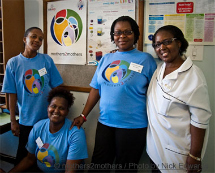 Robin: For Mentor Mothers, it’s an initial two-week training course, and for Site Coordinators, the training lasts three weeks. It’s full-time training. We train mentor mothers in everything to do with HIV/AIDS and PMTCT (Prevention of Mother-to-Child Transmission). In fact, the medical teams in our clinics often ask if they can participate because they recognize that our Mentor Mothers end up knowing more about PMTCT and HIV than the clinical staff! A lot of emphasis is also placed on feeding (exclusive feeding by either breast or bottle) and nutrition—all of those things that are critically important to new mothers. The training also focuses on disclosure and combating stigma as well as family planning, reproductive health, and medications that are available, ARVs (anti-retro virals, HAART treatment). So there’s a lot of information that the women have to assimilate. And they have to learn how to counsel, how to talk to and listen to other women. When you consider that so many of our Mentor Mothers and our patients have minimal literacy and numeracy skills, it’s very impressive what the Mentor Mothers are able to accomplish through their training.
Robin: For Mentor Mothers, it’s an initial two-week training course, and for Site Coordinators, the training lasts three weeks. It’s full-time training. We train mentor mothers in everything to do with HIV/AIDS and PMTCT (Prevention of Mother-to-Child Transmission). In fact, the medical teams in our clinics often ask if they can participate because they recognize that our Mentor Mothers end up knowing more about PMTCT and HIV than the clinical staff! A lot of emphasis is also placed on feeding (exclusive feeding by either breast or bottle) and nutrition—all of those things that are critically important to new mothers. The training also focuses on disclosure and combating stigma as well as family planning, reproductive health, and medications that are available, ARVs (anti-retro virals, HAART treatment). So there’s a lot of information that the women have to assimilate. And they have to learn how to counsel, how to talk to and listen to other women. When you consider that so many of our Mentor Mothers and our patients have minimal literacy and numeracy skills, it’s very impressive what the Mentor Mothers are able to accomplish through their training.
We also have to teach the Mentor Mothers reporting skills—how to gather information, how to use log books, what the evaluative process is. Our Site Coordinators have an additional week’s component of management skills. For each of our moms, another prerequisite is that she has to open her own banking account, which nobody else can access. So we teach each woman how to save, how to do basic banking, how to avoid debt. It’s a lot of information that they have to learn.
W4: Generally, are the Mentor Mothers motivated? Do they respond well to the training? And, have there been challenges in the training?
Robin: There are always challenges, but rarely concerning the women’s motivation. Rather, as we expand, the challenge is to make sure the curriculum continues to be culturally adapted so that it’s appropriate for the communities in which the women live. mothers2mothers is not a cookie-cutter program and we make every effort to be sensitive to the real world that our mothers have to navigate. We generally hire local people to run the programs to ensure that they continue to respond to the real needs of real people and that we incorporate continual recommendations provided by global health agencies like the World Health Organization.
W4: What reactions do you receive, especially in response to the training program, from the families of the Mentor Mothers, especially their husbands, male partners or male relatives?
Robin: Frankly, the men are always the biggest challenge. It is something that we are very, very cognizant of with the women, particularly if the women are afraid to disclose their HIV status to their partners. It’s something we work a lot on—how to communicate with partners and with mothers-in-law (who often spend a lot of time with the mothers and their babies)—because if the women can’t disclose their status to their partners and mothers-in-law, then it’s really difficult for them to make the kinds of choices that are healthy for themselves and their children, especially with respect to feeding and medical treatment. As you know, men often refuse to get tested or refuse to get treatment, so the women in our program really have to work on educating their spouses and partners. It is still common for men to turn on their partners for being the ones to bring shame into the home—even when it is the men who have infected their wives! Women can be shunned, abused, or worse. The mothers know their partners best and know what they can or can’t disclose, and our Mentor Mothers are often part of the process of involving partners and mothers-in-law, so that they can be educated as well, accompanying women to their townships, communities or homes, and helping our patients to talk with their families.
One of my favorite stories, which one of our women (Gloria) often tells—and this happens over and over—is about accompanying one of her young women patients to her hut, because the young woman wanted to disclose her HIV status to her whole family. She gathered together with all of her five brothers and sisters and her parents, and they were sitting on the floor of her house, and this brave, young woman disclosed her condition. Then, one by one, each of her five brothers and sisters disclosed that he or she, too, was living with HIV and had been afraid to share the truth with the family. So it was a way for this family to come together and support one another in seeking treatment. That’s the upside; that’s a happy story. Then, of course, there are the cases where the women are evicted from their homes and have their children taken away from them. Mentor Mothers have to deal with both scenarios.
You know, women are the same all over the world; their number one priority, if they are expecting a baby, is the health and safety of their unborn child. So if pregnant women with HIV are educated to understand that, by taking the appropriate measures, they can have a healthy child and they can stay alive to raise their child, then they will do whatever is necessary to protect their baby in pregnancy and infancy.
W4: How often do women mentored by m2m become mentors themselves? We understand that Mentor Mothers serve a 13-month mentorship position. Do Mentor Mothers tend to remain involved after their 13-month mentorship position ends? How does their role change at that point? And how does m2m help Mentor Mothers transition out of the program?
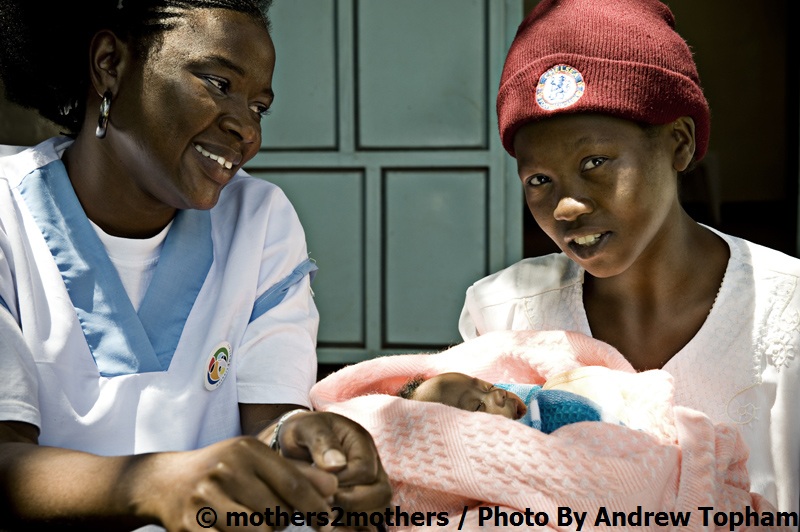
While many of the mothers want to become Mentor Mothers, unfortunately most can’t. In a busy clinic, we can see 400-500 mothers a month, and there may only be five slots for Mentor Mothers. Mentor Mothers replace themselves; they are always on the lookout for other potential Mentor Mothers among the women who enter the program: women who really stand out as the kind of woman that other women would want to talk to. They look for women who are extremely empathetic and who are leaders in the group. They are the ones whom we seek to elevate to the role of Mentor Mothers. Among the Mentor Mothers, the best are then promoted again to become Site Coordinators.
Mentor Mothers can stay in the program for up to two years. It’s a one-year contract with the possibility for renewal. In fact, if the Mentor Mothers are good, then most contracts are renewed. (If it’s not working out well, the contract is not renewed for the second year.) So the Mentor Mothers have a lot of time to look for other employment, because they know well in advance when their two-year contract will be over. We try not to keep the Mentor Mothers in the program beyond the 18-months because we need to make room for incoming pregnant women and the women need to move beyond our program. But, even after the end of the Mentor Mothers program, we hear about former Mentor Mothers and women staying in touch, maintaining their own sort of support systems, because they do all come from the same communities.
W4: How does m2m help Mentor Mothers transition out of the program? What sorts of employment opportunities are available, and what activities do these mothers participate in, afterwards?
Robin: This is really a difficult question and one of our biggest challenges. We are not an employment organization. Our primary function is PMTCT (Prevention of Mother-to-Child Transmission). By the same token, we have created an army of empowered, educated women and we want to see them continue to succeed and spread their knowledge. Many of our mothers actually do go on to become community healthcare workers or counselors. Many of them go back to school and study for degrees. In a country like Swaziland, for example, we’re finding that approximately 70 percent of our graduating Mentor Mothers are going on to employment in related fields. We are trying very hard to work with Ministries of Health and other NGOs and bilateral organizations to create a more formal transitional program at the end of the mentoring program. Indeed, that’s kind of my dream. That hasn’t happened yet, or rather only on an ad hoc basis. Again, we do give the women enough time to seek other livelihood opportunities; the Mentor Mothers know from the beginning that they will not have a long-term, unlimited contract. It is a hard situation but we have a good reason for this policy. For the success of the program, it is vitally important that Mentor Mothers are true peers, that the experience of pregnancy is fresh for them so that their mentorship is not based on memory but on recent experience. Our Site Coordinators, however, are regular employees with open-ended contracts.
W4: We understand that m2m’s three main objectives are 1) to prevent HIV transmission at birth, 2) to increase access to healthcare for HIV-infected women, and 3) to empower women living with AIDS, enabling them to resist stigma and lead productive lives. Have you been equally successful in achieving all three aims? If not, can you elaborate?
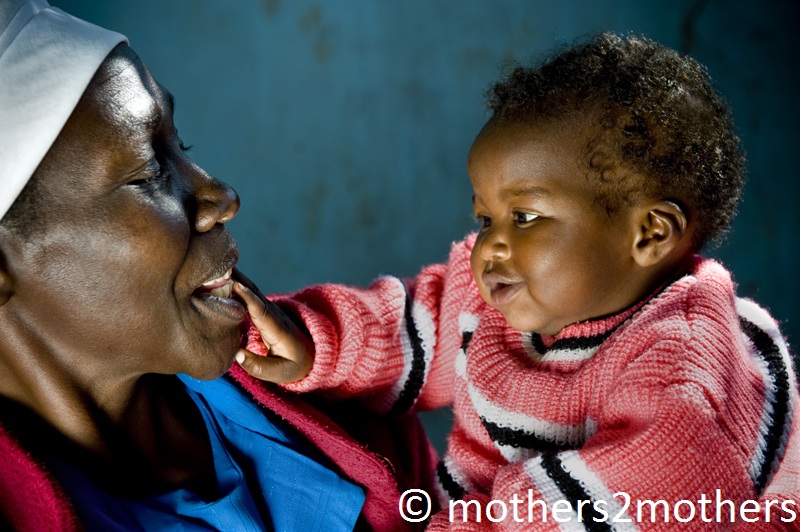
Robin: I think we have been pretty equally successful with all three of the objectives you describe, but it’s interesting that that’s your takeaway because, officially, our three goals are: preventing HIV transmission, keeping mothers alive, and fighting stigma in communities. Of these three, I would say we have been extremely successful in achieving the first objective. The second is harder to quantify because we don’t have the means to monitor mothers indefinitely.The same applies to the issue of stigma. However, in our last independent evaluation it was clear that mothers in our program are more likely to disclose, to select and adhere to an exclusive feeding option, to know and understand their CD4 count, to feel better able to help themselves and to care for their infants and live well.
W4: Can you tell us about your community outreach and education/support work? Have you observed an effect on HIV transmission rates within the communities where m2m is well implanted?
Robin: We are very much clinically based; we are not a community-based program. That said, our mothers—because they are from the communities—naturally do a lot of outreach. One of the things we are exploring at the moment is potential partnerships with other NGOs that are community-based, in order to establish more formal linkages so that we really can support each other’s work. In this way, if there’s a lot of follow-up to do with a mother from the clinic, we can work with someone in the community to achieve that, and vice versa. We are now doing a number of studies and working with Johnson & Johnson on using cell phone technology as a way to retain women who are lost in the PMTCT cascade and to work on behalf of early infant diagnosis, bringing women back to our program through e-mail reminders.
We have done two studies, one in Kenya and one in South Africa, that have strongly indicated the effectiveness of using cell phone technology: it’s a huge success in terms of bringing women back to the clinics and getting their babies tested. This is something that we are actively following up at the moment through a wonderful partnership with Hewlett Packard, and we are also looking at incentivization programs using cell phones. For example, incentivising women by giving them free minutes when they come back to the clinic. There are all kinds of ways now that we can use cell phones as an important tool to access women even in low population, low prevalence areas.
These programs are proving to work well and we are excited to see where this will take us in the future! It’s surprising that cell phone usage is considerably higher in Africa than it is in the U.S. You go out there and there may not be anything else in the village, but there will be a cell phone, even if it is shared by the entire village. We even looked at the difference in effectiveness of home visits compared with reminders via cell phones, and, interestingly, the use of cell phones was more successful.
W4: How do you measure the impact of your work?
Robin: Last year we developed a new set of logbooks that are wonderful and have a whole slew of outcomes that are measured every day, compiled weekly and sent to our M&E (Monitoring and Evaluations) team in Cape Town for review. In terms of evaluations that have already been done, you can access them online. The Population Council did a wonderful evaluation of the program in 2007, in terms of looking at the psychosocial support component; they looked at the family planning component, and a whole slew of different things. That was back in 2007, and certainly the program has significantly developed since then.
W4: m2m has been able to replicate its model and programs in other countries in Africa. Do different geographical and cultural contexts significantly affect your work and require you to adapt your model? If so, can you provide examples?
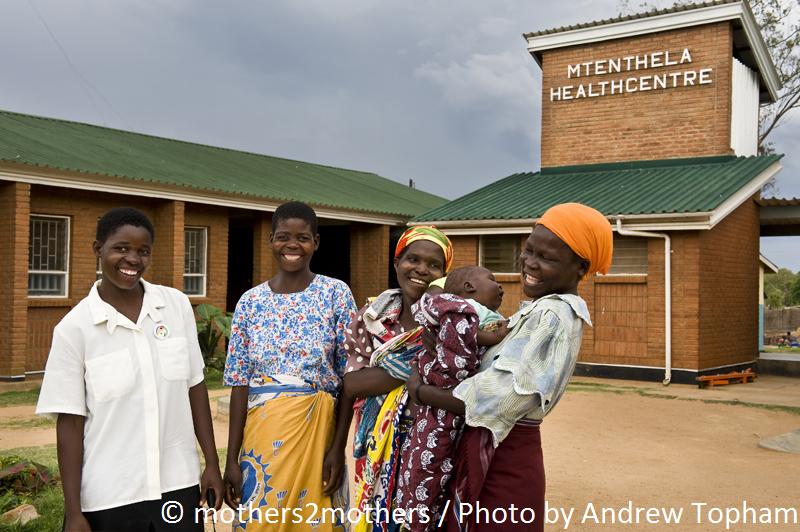
Robin: As I said, we put a lot of time and energy into making sure that the program is culturally relevant and sensitive. We do that by employing local people to guide us and ensure that we are never in a position where we are imposing our standards and our values on somebody else’s community. That’s the first thing.
In addition to the cultural aspects, we have to adapt the program in terms of what is economically feasible in the given context. For example, our first international expansion from South Africa was to Lesotho. Lesotho has very challenging geographical terrain—it’s a very rural, mountainous region, and very poor. Our traditional direct implementation model did not work as well, so for Lesotho we adapted the program and used what we call a “cluster model”. Rather than having Mentor Mothers and Site Coordinators in every health facility, as we have been doing in South Africa, we started “clustering” sites: we kept a Site Coordinator at the main maternity unit hospital, and then worked with clinics so they would schedule their antenatal clinics and postnatal clinics on different days, enabling us to send our Mentor Mothers out from the central location, say to one tiny clinic in one area on a Monday and another clinic on a Tuesday and another one on a Wednesday. It was much more cost-effective than it would have been to service all those smaller, mountainous clinics, as we would have done in South Africa.
Of course, it’s a huge, ongoing challenge. As we reach out to more rural areas, the challenge grows more difficult. Women in a township might be willing to attend a clinic every day, whereas it’s much harder to get a woman who is heavily pregnant to come into a clinic if she has to walk five hours to get there. I can’t say that we have resolved this issue other than to try to incentivise the women as much as possible to come to the clinics as often as they can. Ideally, we need to ensure that a participant comes to the clinic a minimum of three times during her pregnancy. That’s what we find is necessary to get the minimum benefit of the program. If it’s fewer than three times, there really is a significant drop-off in the amount of information that our clients receive. We try as hard as we can to make the experience and benefits positive and obvious enough that each woman will attend the program as often as possible, given her constraints.
W4: What are the greatest challenges that you face in your work at m2m? The greatest obstacles you have had to overcome to ensure the success of your program?
Robin: The greatest challenge continues to be financial support. We can say that we are now reaching 20 percent of the global population of HIV-positive pregnant women. That’s great, but that still leaves 80 percent of the population of HIV-positive pregnant women without the support they need. There are so many countries and so many places that desperately want and need a program like mothers2mothers. But we are hindered by financial constraints, so the more money we can raise, the more women we can reach out to—which means more babies will have the chance of a healthy future. The financial obstacle always continues to be the greatest challenge and, in our current global economy, it will continue to be so for the foreseeable future.
The second challenge is inadequate infrastructure in the countries in which we operate. There is little we can do about that, unfortunately. We can only support and follow WHO (World Health Organization) guidelines as best we can. But if the medicines are not available, if the roads don’t exist to transport the drugs to the townships and clinics, then there’s simply nothing we can do about those difficulties. We have to persevere and support local efforts as best we can and utilize whatever means are available.
W4: Since becoming involved with m2m, is there a particular story that has remained with you?
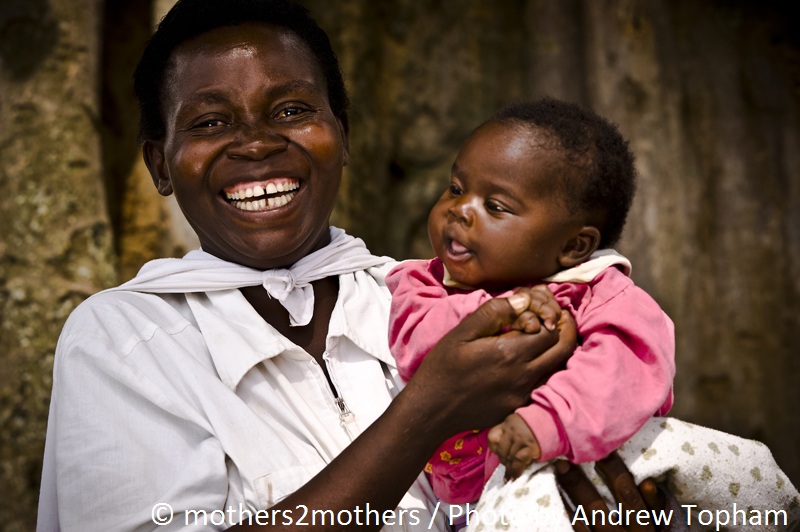
Robin: There are so many uplifting stories. There is Kunene, for example, whom I’m very close to, and who is one of our original Mentor Mothers. She was a runaway from an abusive situation when she was a kid on the streets. She came to us when she was nine months pregnant and Mitch was her doctor (this was right at the beginning of the program). When she showed up, she was at a CD4 count (T-cell count) of two! Two, at nine months pregnant! She should not have been alive. Mitch was her doctor and cared for her and brought her back to health. Kunene became one of our first Mentor Mothers. Kunene was a school dropout as a youngster, but she went back to school. After school, she became a Site Coordinator and then a Senior Site Coordinator, and this year she graduated from university with a Masters in Psychology. Kunene plans to continue counseling HIV-positive mothers in the best way she can. She is married to a wonderful HIV-negative man, and has two beautiful HIV-negative children.
We have Mentor Mothers who have saved every dime they earned and have bought companies or taxi services. They are now the ones supporting their whole extended families thanks to the money they earned as Mentor Mothers.
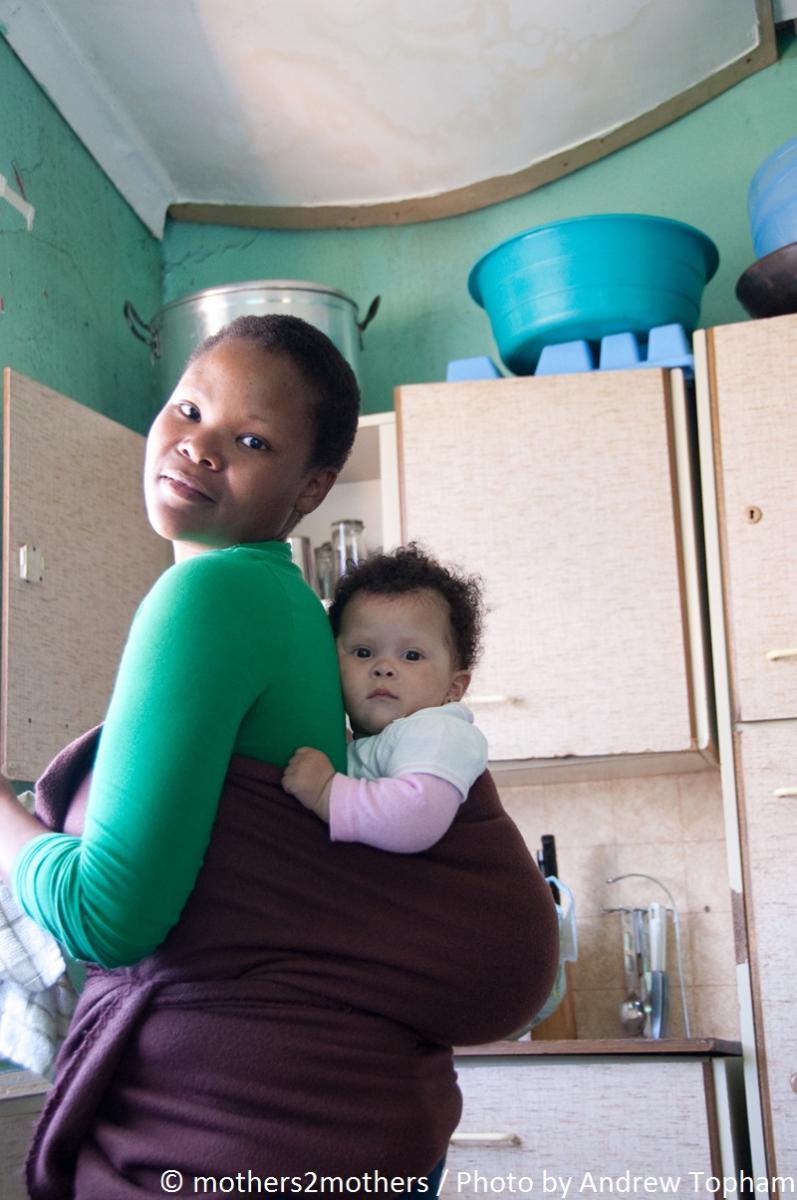 There are just countless stories of women who have become empowered and successful. There’s the case of Nozi, who stayed with me recently here at my home in Los Angeles. Nozi came to us when she was 21 years old and pregnant. Literally, she couldn’t look you in the eyes. Thanks to the program, she has become an entirely different person, so empowered, within just months. The first time that she ever left Cape Town, we flew her to Washington, DC for a briefing before Congress. She stood there and told them (Congress) what they should and shouldn’t be doing. She was just amazing, standing there, addressing Congress. She is an extraordinary person. Nozi had a little boy who was born HIV-negative. He was the love of her life. Tragically, he was hit by a taxi in a horrible accident this year and died at at the age of four. It was so awful. Rather than succumbing to this horrible tragedy, Nozi has moved forward courageously and continues to speak out on behalf of mothers around the world. She is one of our main spokespersons; she is 24 years old and runs our busiest clinic in Khayelitsha, which serves 500 new women every month. That’s how Nozi has dealt with her tragedy—by trying to help others. And there are thousands of women like her, women who refuse to let living in abject poverty and living with HIV/AIDS defeat them, women who are mothers like we are. My friends and I share the same dreams: to have the opportunity to watch our babies grow up to become adults who are happy and healthy in a world where their own babies will be safe.
There are just countless stories of women who have become empowered and successful. There’s the case of Nozi, who stayed with me recently here at my home in Los Angeles. Nozi came to us when she was 21 years old and pregnant. Literally, she couldn’t look you in the eyes. Thanks to the program, she has become an entirely different person, so empowered, within just months. The first time that she ever left Cape Town, we flew her to Washington, DC for a briefing before Congress. She stood there and told them (Congress) what they should and shouldn’t be doing. She was just amazing, standing there, addressing Congress. She is an extraordinary person. Nozi had a little boy who was born HIV-negative. He was the love of her life. Tragically, he was hit by a taxi in a horrible accident this year and died at at the age of four. It was so awful. Rather than succumbing to this horrible tragedy, Nozi has moved forward courageously and continues to speak out on behalf of mothers around the world. She is one of our main spokespersons; she is 24 years old and runs our busiest clinic in Khayelitsha, which serves 500 new women every month. That’s how Nozi has dealt with her tragedy—by trying to help others. And there are thousands of women like her, women who refuse to let living in abject poverty and living with HIV/AIDS defeat them, women who are mothers like we are. My friends and I share the same dreams: to have the opportunity to watch our babies grow up to become adults who are happy and healthy in a world where their own babies will be safe.
We invite you to find out more about mothers2mothers and to make a donation to the organization’s vital work.
© Women’s WorldWide Web 2011













